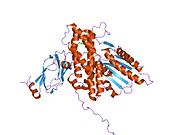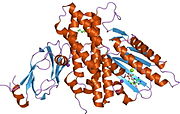Biology:PDK3
 Generic protein structure example |
Pyruvate dehydrogenase lipoamide kinase isozyme 3, mitochondrial is an enzyme that in humans is encoded by the PDK3 gene.[1] [2] It codes for an isozyme of pyruvate dehydrogenase kinase.The pyruvate dehydrogenase (PDH) complex is a nuclear-encoded mitochondrial multienzyme complex that catalyzes the overall conversion of pyruvate to acetyl-CoA and CO2. It provides the primary link between glycolysis and the tricarboxylic acid (TCA) cycle, and thus is one of the major enzymes responsible for the regulation of glucose metabolism. The enzymatic activity of PDH is regulated by a phosphorylation/dephosphorylation cycle, and phosphorylation results in inactivation of PDH. The protein encoded by this gene is one of the four pyruvate dehydrogenase kinases that inhibits the PDH complex by phosphorylation of the E1 alpha subunit. This gene is predominantly expressed in the heart and skeletal muscles. Alternatively spliced transcript variants encoding different isoforms have been found for this gene.[2]
Structure
The structure of the PDK3/L2 complex has been elucidated, and there are several key features. When the L2 domain binds to PDK3, it induces a “cross-tail” conformation in PDK3, thereby stimulating activity. There are three crucial residues, Leu-140, Glu-170, and Glu-179, in the C-terminal domain that are crucial for this interaction.[3] Structural studies have indicated that L2 binding stimulates activity by disrupting the closed conformation, or ATP lid, to remove product inhibition.[4] The PDK3 subunits are in one of two conformations; one subunit exists as an “open” subunit, while the other subunit is “closed”. The open subunit is the configuration most crucial to the putative substrate-binding cleft, as it is where the target peptide can access the active center. The closed subunit blocks this target peptide because of a neighboring unwound alpha helix. Additionally, the ATP-binding loop in one PDK3 subunit adopts an open conformation, implying that the nucleotide loading into the active site is mediated by the inactive "pre-insertion" binding mode. This asymmetric complex represents a physiological state in which binding of a single L2-domain activates one of the PDHK subunits while inactivating another.[5] Thus, the L2-domains likely act not only as the structural anchors but also modulate the catalytic cycle of PDK3.
Function
The Pyruvate Dehydrogenase (PDH) complex must be tightly regulated due to its central role in general metabolism. Within the complex, there are three serine residues on the E1 component that are sites for phosphorylation; this phosphorylation inactivates the complex. In humans, there have been four isozymes of Pyruvate Dehydrogenase Kinase that have been shown to phosphorylate these three sites: PDK1, PDK2, PDK3, and PDK4.[6] The PDK3 protein is primarily found in the kidney, brain, and testis.[7]
Regulation
As the primary regulators of a crucial step in the central metabolic pathway, the pyruvate dehydrogenase family is tightly regulated itself by a myriad of factors. PDK3, in conjunction with PDK2 and PDK4, are primary targets of peroxisome proliferator-activated receptor delta/beta (PPAR beta/delta), with PDK3 having five elements that respond to these receptors.[8]
References
- ↑ "Diversity of the pyruvate dehydrogenase kinase gene family in humans". The Journal of Biological Chemistry 270 (48): 28989–94. Dec 1995. doi:10.1074/jbc.270.48.28989. PMID 7499431.
- ↑ 2.0 2.1 "Entrez Gene: PDK3 pyruvate dehydrogenase kinase, isozyme 3". https://www.ncbi.nlm.nih.gov/sites/entrez?Db=gene&Cmd=ShowDetailView&TermToSearch=5165.
- ↑ "Structural determinants for cross-talk between pyruvate dehydrogenase kinase 3 and lipoyl domain 2 of the human pyruvate dehydrogenase complex". The Journal of Biological Chemistry 281 (37): 27197–204. Sep 2006. doi:10.1074/jbc.M604339200. PMID 16849321.
- ↑ "Crystal structure of pyruvate dehydrogenase kinase 3 bound to lipoyl domain 2 of human pyruvate dehydrogenase complex". The EMBO Journal 24 (10): 1763–74. May 2005. doi:10.1038/sj.emboj.7600663. PMID 15861126.
- ↑ "Crystal structure of an asymmetric complex of pyruvate dehydrogenase kinase 3 with lipoyl domain 2 and its biological implications". Journal of Molecular Biology 370 (3): 407–16. Jul 2007. doi:10.1016/j.jmb.2007.04.083. PMID 17532006.
- ↑ "Regulation of pyruvate dehydrogenase activity through phosphorylation at multiple sites". The Biochemical Journal 358 (Pt 1): 69–77. Aug 2001. doi:10.1042/0264-6021:3580069. PMID 11485553.
- ↑ "Therapeutic potential of the mammalian pyruvate dehydrogenase kinases in the prevention of hyperglycaemia". Current Drug Targets. Immune, Endocrine and Metabolic Disorders 2 (2): 151–65. Jul 2002. doi:10.2174/1568005310202020151. PMID 12476789.
- ↑ "Three members of the human pyruvate dehydrogenase kinase gene family are direct targets of the peroxisome proliferator-activated receptor beta/delta". Journal of Molecular Biology 372 (2): 341–55. Sep 2007. doi:10.1016/j.jmb.2007.06.091. PMID 17669420.
Further reading
- "Therapeutic potential of the mammalian pyruvate dehydrogenase kinases in the prevention of hyperglycaemia". Current Drug Targets. Immune, Endocrine and Metabolic Disorders 2 (2): 151–65. Jul 2002. doi:10.2174/1568008023340785. PMID 12476789.
- "Recent advances in mechanisms regulating glucose oxidation at the level of the pyruvate dehydrogenase complex by PDKs". American Journal of Physiology. Endocrinology and Metabolism 284 (5): E855–62. May 2003. doi:10.1152/ajpendo.00526.2002. PMID 12676647. http://pdfs.semanticscholar.org/e382/014c36b14bf9f49e859a56b3b9735b820b84.pdf.
- "Marked differences between two isoforms of human pyruvate dehydrogenase kinase". The Journal of Biological Chemistry 275 (21): 15773–81. May 2000. doi:10.1074/jbc.M909488199. PMID 10748134.
- "Regulation of pyruvate dehydrogenase activity through phosphorylation at multiple sites". The Biochemical Journal 358 (Pt 1): 69–77. Aug 2001. doi:10.1042/0264-6021:3580069. PMID 11485553.
- "Site specificity of four pyruvate dehydrogenase kinase isoenzymes toward the three phosphorylation sites of human pyruvate dehydrogenase". The Journal of Biological Chemistry 276 (40): 37223–9. Oct 2001. doi:10.1074/jbc.M103069200. PMID 11486000.
- "Interaction between the individual isoenzymes of pyruvate dehydrogenase kinase and the inner lipoyl-bearing domain of transacetylase component of pyruvate dehydrogenase complex". The Biochemical Journal 366 (Pt 1): 129–36. Aug 2002. doi:10.1042/BJ20020301. PMID 11978179.
- "Pyruvate dehydrogenase activation and kinase expression in human skeletal muscle during fasting". Journal of Applied Physiology 96 (6): 2082–2087. Jun 2004. doi:10.1152/japplphysiol.01318.2003. PMID 14966024. http://pdfs.semanticscholar.org/5f70/1e68909a34e6fe0471b412297082edb7e582.pdf.
- "Genomic analysis of mouse retinal development". PLOS Biology 2 (9): E247. Sep 2004. doi:10.1371/journal.pbio.0020247. PMID 15226823.
- "Crystal structure of pyruvate dehydrogenase kinase 3 bound to lipoyl domain 2 of human pyruvate dehydrogenase complex". The EMBO Journal 24 (10): 1763–74. May 2005. doi:10.1038/sj.emboj.7600663. PMID 15861126.
- "Towards a proteome-scale map of the human protein-protein interaction network". Nature 437 (7062): 1173–8. Oct 2005. doi:10.1038/nature04209. PMID 16189514. Bibcode: 2005Natur.437.1173R.
- "Structural determinants for cross-talk between pyruvate dehydrogenase kinase 3 and lipoyl domain 2 of the human pyruvate dehydrogenase complex". The Journal of Biological Chemistry 281 (37): 27197–204. Sep 2006. doi:10.1074/jbc.M604339200. PMID 16849321.
- "Crystal structure of an asymmetric complex of pyruvate dehydrogenase kinase 3 with lipoyl domain 2 and its biological implications". Journal of Molecular Biology 370 (3): 407–16. Jul 2007. doi:10.1016/j.jmb.2007.04.083. PMID 17532006.
- "Three members of the human pyruvate dehydrogenase kinase gene family are direct targets of the peroxisome proliferator-activated receptor beta/delta". Journal of Molecular Biology 372 (2): 341–55. Sep 2007. doi:10.1016/j.jmb.2007.06.091. PMID 17669420.
- "Distinct structural mechanisms for inhibition of pyruvate dehydrogenase kinase isoforms by AZD7545, dichloroacetate, and radicicol". Structure 15 (8): 992–1004. Aug 2007. doi:10.1016/j.str.2007.07.001. PMID 17683942.
 |




